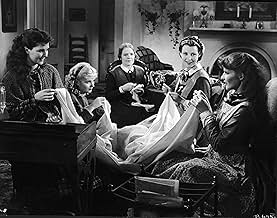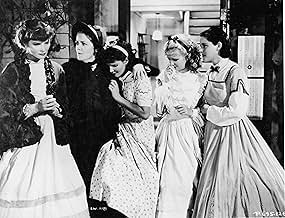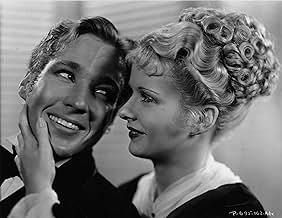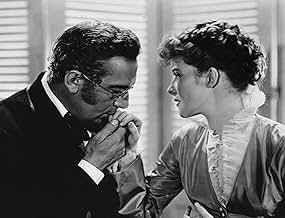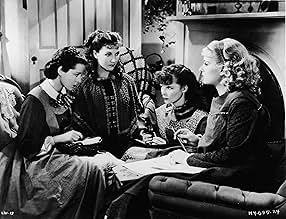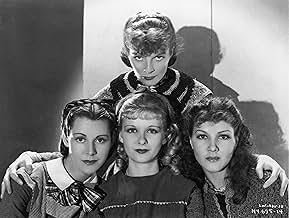VALUTAZIONE IMDb
7,2/10
8091
LA TUA VALUTAZIONE
Una cronaca della vita di sorelle che crescono nell'America del novecento.Una cronaca della vita di sorelle che crescono nell'America del novecento.Una cronaca della vita di sorelle che crescono nell'America del novecento.
- Vincitore di 1 Oscar
- 5 vittorie e 4 candidature totali
John Lodge
- Brooke
- (as John Davis Lodge)
Samuel S. Hinds
- Mr. March
- (as Samuel Hinds)
Nina Borget
- Housekeeper
- (non citato nei titoli originali)
Francesca Braggiotti
- Dance Teacher
- (non citato nei titoli originali)
Luke Cosgrave
- Old Man
- (non citato nei titoli originali)
Trama
Lo sapevi?
- QuizKatharine Hepburn asked costume designer Walter Plunkett to copy a dress her maternal grandmother wore in a tintype photograph.
- BlooperIn the Christmas play when the prop tower falls down, Jo's lips aren't moving when she says "Everything is all right."
- Curiosità sui creditiPaul Lukas as Professor Bher is not listed in the closing credits.
- Versioni alternativeOlder video and television prints remove the original RKO logo in the opening and replace it with the one from Selznick International.
- ConnessioniFeatured in David O. Selznick: 'Your New Producer' (1935)
- Colonne sonoreThe Girl I Left Behind Me
(uncredited)
Traditional
Played during the opening scene
Recensione in evidenza
This satisfying movie adaptation of "Little Women" features a strong cast and a production that was quite solid for 1933. While a glance at the story outline might give the impression that it is simplistic or childlike, that is far from the case. The novel offers well-defined characters and many situations that bring out worthwhile insights into the characters and into life in general. While neither this nor the other movie versions of the story have the same thematic depth, this version effectively presents enough of the material in a thoughtful and entertaining way.
Katherine Hepburn heads the cast, and gives plenty of life to Jo. Naturally she gets the main focus, but the other sisters and the secondary characters also get some good moments, and most of them get a chance to steal a scene or two. Henry Stephenson and Douglas Montgomery get a number of good scenes as the March family's neighbors. Edna May Oliver is well cast, and it's only too bad that she did not get a couple more scenes. Paul Lukas makes Professor Baer come alive. By no means least are Jean Parker, Frances Dee, and Joan Bennett as Beth, Meg, and Amy.
It is often easy to tell when the movie was made, most especially because of the sound. But actually the production is better technically and artistically than are most movies of the early 1930s. Several of the sets are particularly well done, creating just the right atmosphere for their scenes. Director George Cukor puts it all together nicely.
This is the kind of movie that is generally out of style at present, because it lacks the kind of self-indulgent material and the self-absorbed style that so unduly impress many of today's movie fans. But the only genuine weakness is that it has a few technical limitations, most of which are common to many films of its era.
What this adaptation does offer is a sympathetic and sometimes insightful look at the lives of some ordinary but strong persons, who are brought to life by a good cast and a director who seemed himself to care about the characters.
Katherine Hepburn heads the cast, and gives plenty of life to Jo. Naturally she gets the main focus, but the other sisters and the secondary characters also get some good moments, and most of them get a chance to steal a scene or two. Henry Stephenson and Douglas Montgomery get a number of good scenes as the March family's neighbors. Edna May Oliver is well cast, and it's only too bad that she did not get a couple more scenes. Paul Lukas makes Professor Baer come alive. By no means least are Jean Parker, Frances Dee, and Joan Bennett as Beth, Meg, and Amy.
It is often easy to tell when the movie was made, most especially because of the sound. But actually the production is better technically and artistically than are most movies of the early 1930s. Several of the sets are particularly well done, creating just the right atmosphere for their scenes. Director George Cukor puts it all together nicely.
This is the kind of movie that is generally out of style at present, because it lacks the kind of self-indulgent material and the self-absorbed style that so unduly impress many of today's movie fans. But the only genuine weakness is that it has a few technical limitations, most of which are common to many films of its era.
What this adaptation does offer is a sympathetic and sometimes insightful look at the lives of some ordinary but strong persons, who are brought to life by a good cast and a director who seemed himself to care about the characters.
- Snow Leopard
- 16 nov 2004
- Permalink
I più visti
Accedi per valutare e creare un elenco di titoli salvati per ottenere consigli personalizzati
Dettagli
- Data di uscita
- Paese di origine
- Lingue
- Celebre anche come
- Little Women
- Luoghi delle riprese
- Providencia Ranch, Hollywood Hills, Los Angeles, California, Stati Uniti(exterior of March house)
- Azienda produttrice
- Vedi altri crediti dell’azienda su IMDbPro
Botteghino
- Budget
- 424.000 USD (previsto)
- Tempo di esecuzione1 ora 55 minuti
- Proporzioni
- 1.37 : 1
Contribuisci a questa pagina
Suggerisci una modifica o aggiungi i contenuti mancanti

Divario superiore
By what name was Piccole donne (1933) officially released in India in English?
Rispondi

